Last updated: May 27, 2021
Article
The Great War Monuments
The Great War’s Impact
Mammoth Cave’s modern history started off around the turn of the 19th century with it serving as an important saltpeter mine and contained curious artifacts from a even earlier time when Native Americans explored the cave passageways. By the time the United States of America entered World War I in 1917, Mammoth Cave’s reputation as an interesting tourist attraction had reached an international audience.
With over 4.5 million servicemen committed to the Great War in Europe, a group of women came together to form the American War Mothers. These ladies united to help one another and to send support and encouragement overseas to America’s fighting forces.
When the fog of war cleared, it was learned that 116,516 of service members would not return home. In response to these devastating losses, the American Legion organization formed out of a desire to provide service to veterans, servicemembers and communities.
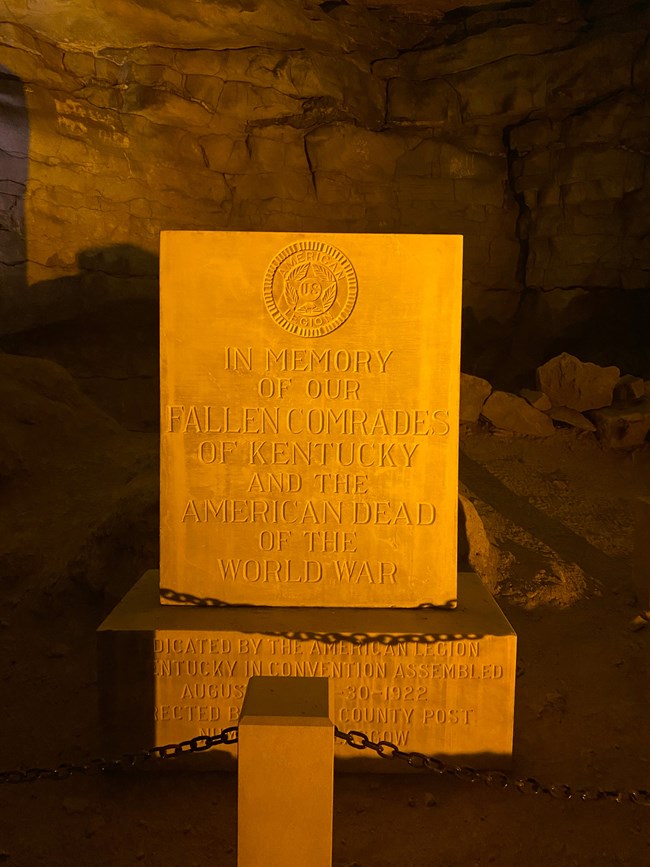
NPS Photo
Before a Park, a Memorial
In 1922, the Barren County, KY Post 28 of the American Legion distributed a request to the state’s governors to each submit a list of names of their service members who had died during World War I. These names would be commemorated into a memorial during the Kentucky state convention in August of that year.
On the last day of the convention, a great ceremony was held at Mammoth Cave to dedicate a monument honoring those who had died during the war. It read:
“IN MEMORY
of our
FALLEN COMRADES
OF KENTUCKY
and the
AMERICAN DEAD
of the
WORLD WAR.”
Inside the base of the large stone monument a chamber had been carved where they placed the list of names of those American who had died.
Brent G. Nunnelley, adjutant, Kentucky, stated of the monument, “...(it) will renew in the hearts of many thousands of visitors to Mammoth Cave each year, a reverence and a gratitude for the sacrifice of America’s sons.” Big Sandy News December 8, 1922.
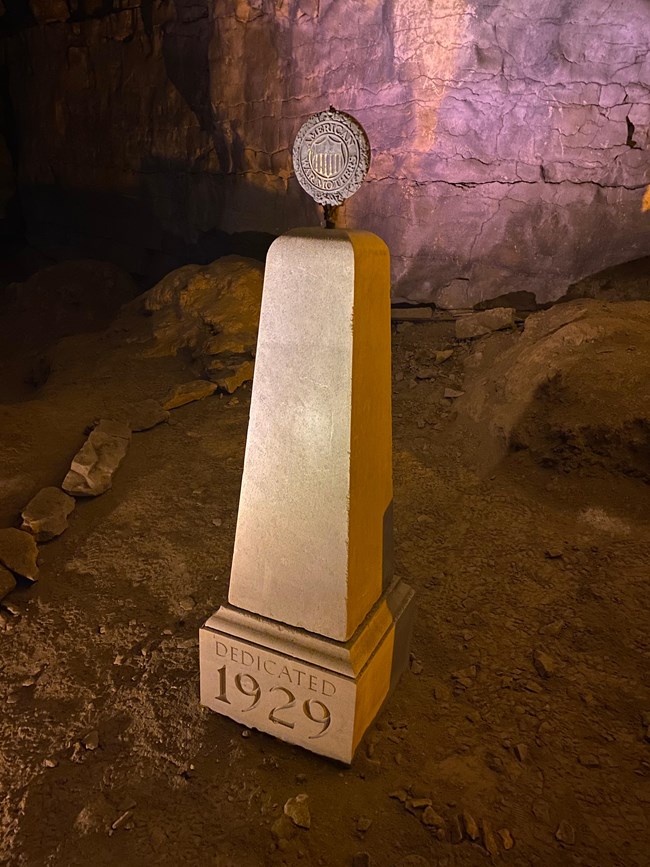
NPS Photo
“This monument will be erected by the members of Barren County Post 28 of Glasgow, which feels that Mammoth Cave will be a most suitable place to perpetuate the undying memory of the heroes of the World War.” Richmond Daily Register, June 10, 1922.
The spot chosen to display the monument was the entrance to the Rotunda room of Mammoth Cave, approximately 700 feet (215 meters) into the cave’s Historic Entrance. Here, the cave widened out into the mammoth passageways and chambers for which the cave was named.
“No more appropriate spot could be chosen for such a national monument than this gigantic hole which winds for miles and miles under the hills and valleys of God’s Garden Spot Kentucky.” Richmond Daily Register, June 10, 1922.
When the American War Mothers held their national convention of 1929 in Louisville, Kentucky, the American Legion memorial within the cave was expanded by the dedication of a second monument, the American War Mothers monument, which was placed next to the one erected by the American Legion.
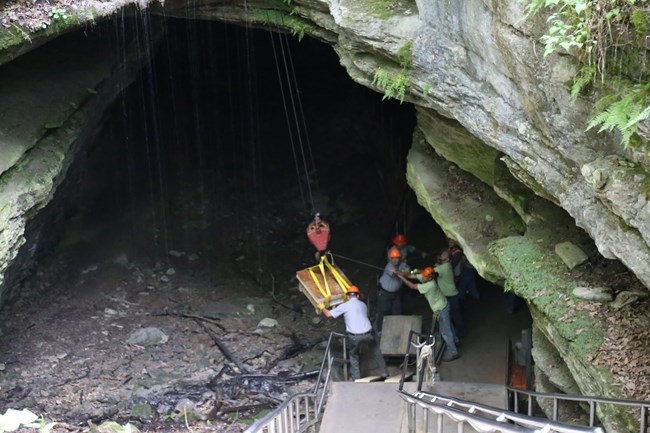
NPS Photo
Lost Over Time
When Mammoth Cave officially entered the National Park Service in 1941, the monuments of the cave had already served for many years as a national memorial and the cave continued serving as a tourist destination. Hundreds of thousands of people visited the park each year for a guided tour of the extensive cave passageways. One of the main tourist routes through the cave passed directly by the two war monuments. This popular route was eventually converted to a self-guided tour in order to accommodate the ever increasing number of visitors to the park. By 1969, the monuments begun to suffer damage from vandalism.
In a June 28, 1922 article on the American Legion monument, The Public Ledger proclaimed, “Storms, fires, vandals, and war may destroy or uproot cemeteries and monuments on the surface of the earth, but nothing less than a violent eruption of the earth itself will ever efface this unusual subterranean cenotaph*.” Nevertheless, Mammoth Cave National Park managers made the decision to remove the monuments from beside the tour route.
The two stone monuments had stood for decades as silent sentinels in the entryway of Mammoth Cave subtly sharing the message of remembrance, but were now relegated to a position behind a pile of rocks in an unvisited part of the cave.
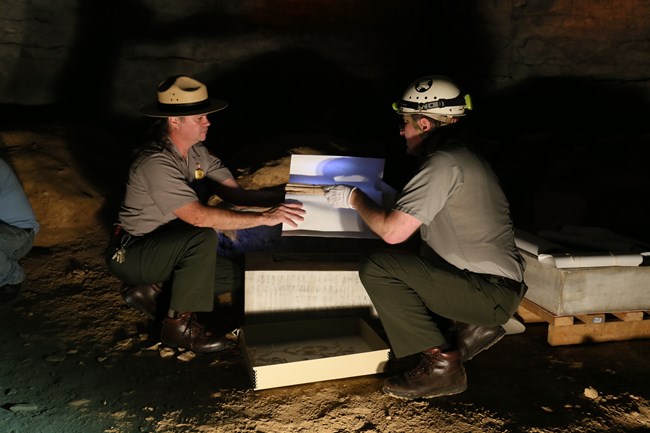
NPS Photo
A Worthy Rededication
During the late 2010’s, the park began an extensive trail rehabilitation project through the historic section of the cave. During the subsequent trail work members of park Interpretive and Resource Management staff began an effort to reinstate the monuments to their original location inside the cave.
In 2017, in coordination with the centennial of World War I, the two monuments were refurbished. The damage caused by years of vandalism was repaired, and what remained of the original documents listing the names of the American dead were once again enshrined inside the base of the American Legion monument. The two monuments were then returned to their original location at the entrance to the Rotunda.
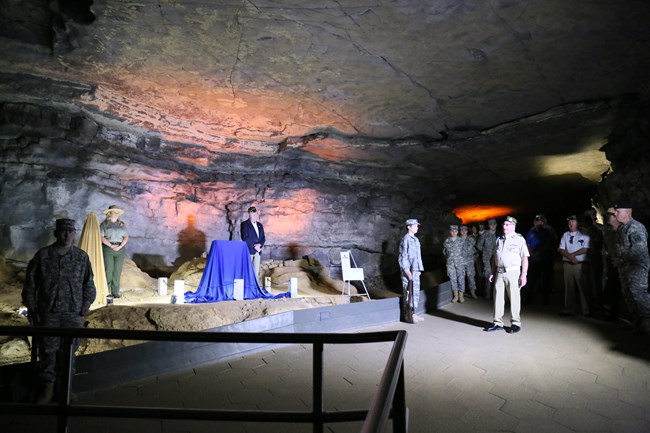
NPS Photo
A rededication ceremony was held on August 30, 2017 on the 95th anniversary of the original dedication of the American Legion monument, and 100 years after the United States of America entered, the Great War. Representatives of the American Legion, the American War Mothers, Barren County Veterans Association, Disabled American Veterans, and Mammoth Cave National Park attended with the local Barren County High School Junior Reserve Officer Training Corps serving as color guard.
“There is now left, naught but memories of heroes, who suffered and died, and the great lesson of patriotism will thus remain, for future generations, until the curtain of life’s drama is drawn for time and eternity. Until then, we may look to Mammoth Cave and its memorial, as one, among the many Meccas, toward which, All Americans should turn for patriotic inspiration.” The Citizen Aug. 17, 1922.
* A monument erected in honor of a person or group whose remains are elsewhere.
